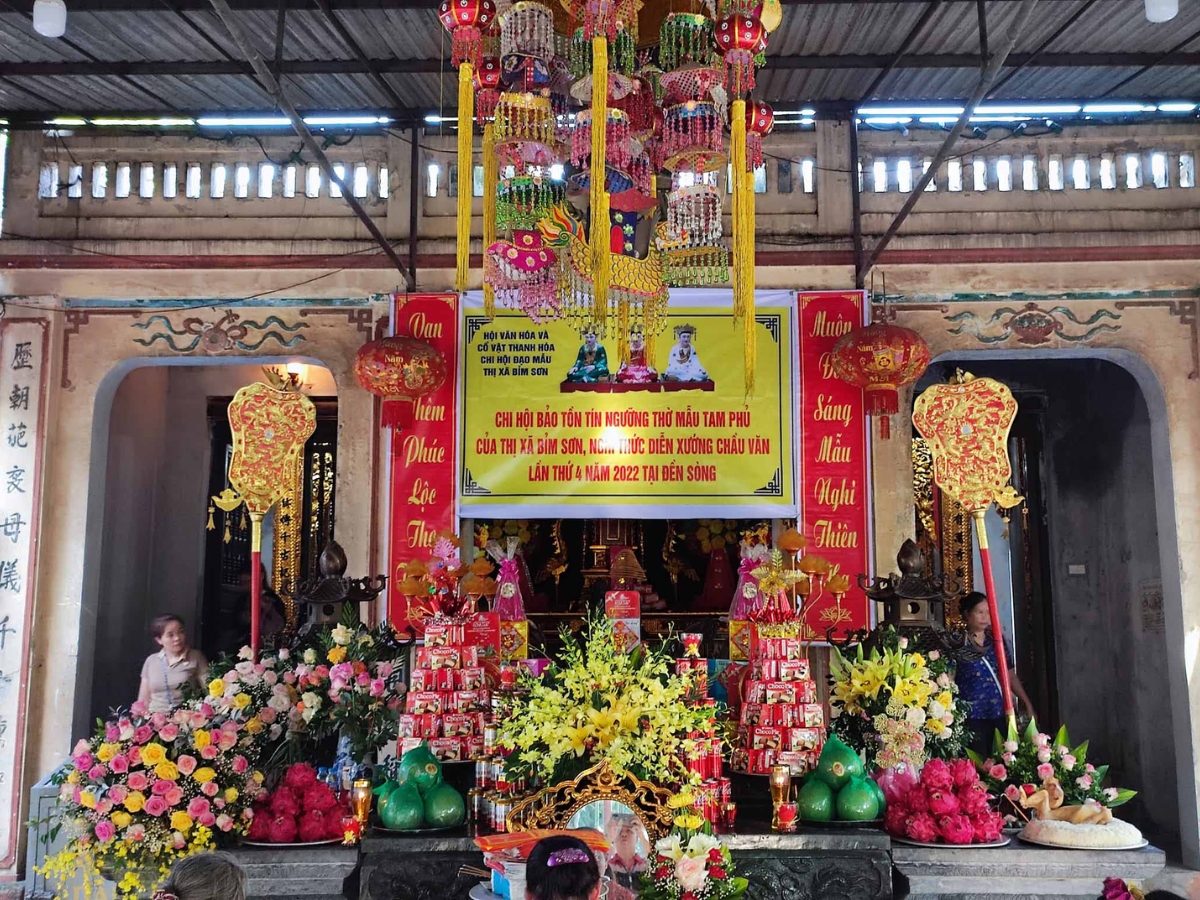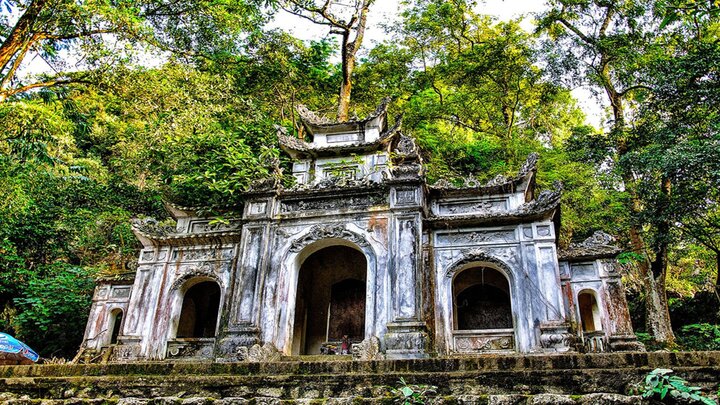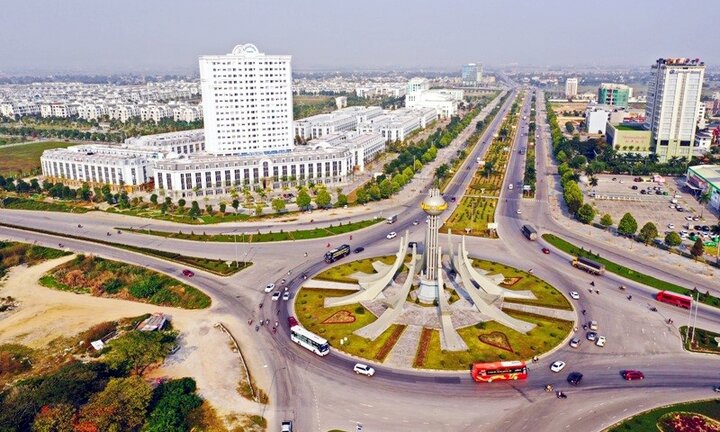1. Overview of Song Son Temple
1.1. Location of Song Son Temple
Located in Quang Trung ward, Thanh Hoa province, Song Son Temple is one of the famous spiritual cultural destinations sought after by many tourists when exploring Thanh Hoa land. The temple is also known by ancient names such as Tung Son or Tung Tran Temple. With a long history, Song Son Temple has become an indispensable part of the spiritual life of the people of Thanh Hoa.
According to folk belief, Song Son Temple is considered the most sacred temple in Thanh Hoa, and also one of the typical structures of the Mother Goddess worship in Vietnam. This is also one of the relics recognized as a National Historical and Cultural Relic, clearly demonstrating the spiritual cultural value of the Thanh Hoa land.
1.2. Who is worshipped at Song Son Temple?
Song Son Temple is where Mother Lieu Hanh is worshipped, one of the “Four Immortals” of Vietnamese folk culture. According to legend, Mother Lieu Hanh was originally Tien Chua Quynh Nuong, the daughter of Ngoc Hoang Thuong De. Due to a mistake in heaven, she was banished to the mortal world, reincarnated into the Le family in old Nam Dinh (now belonging to Ninh Binh province) and was named Giang Tien.

Temple Song Son is where Mau Lieu Hanh is worshipped. (Source: Collected)
After three descents to earth, Mau Lieu Hanh was sent to the mortal realm by the Jade Emperor and did not have to reincarnate again. With her divine powers, she traveled through many lands, helping the virtuous and punishing the wicked. When she traveled to the Song Son and Tam Diep mountain regions, she used her magic to help people cross the Ba Doi pass, teaching them how to dig wells, weave cloth, and grow mulberry trees to raise silkworms.
Grateful for the benevolence of the Immortal Queen, the people of the ancient Co Dam village joined together to build a temple to worship Mau Lieu Hanh. Legend has it that she appeared in a dream to the villagers, urging them to contribute their efforts to build the temple. And from then on, the temple was named Sung Tran, also known as Temple Song Son. This place is considered a sacred symbol, preserving the strong tradition of Mother Goddess worship among Vietnamese people.
1.3. History of Formation and Renovation of Temple Song Son
Current historical records do not specify the exact year Temple Song Son was built. However, the people of the ancient Co Dam village pass down the story that during the Le dynasty, in the Vinh To era (1619 – 1628), an old man in the village received a divine message in a dream from the Immortal Queen Mau Lieu Hanh, guiding him on building the temple. According to the dream message, one morning in late January, he took a bamboo stick to the land that is now the site of Temple Song Son, planted it in the ground, and offered incense with prayers. After some time, a miracle occurred: the bamboo sprouted and grew lush green shoots. The villagers believed it was a sign that Mau Lieu Hanh had manifested her divinity, so they joined forces to build a temple dedicated to her at this very spot.
Over more than four centuries, Temple Song Son has undergone numerous renovations and restorations to preserve its majestic and sacred aura. Notable renovation periods occurred during the Canh Hung era under King Le Hien Tong, followed by the sixth year of Duy Tan (1912), the fourth year of Khai Dinh (1919), the third year of Bao Dai (1928), and in 1939. Each renovation further perfected and expanded the temple, making it a major center of worship for Thanh Hoa province. To this day, Temple Song Son retains its ancient and sacred character, serving as a place where people and visitors from all directions come to pay homage, remember the merits of Mau Lieu Hanh, and pray for peace and happiness.
2. Exploring the Architecture and Sacred Space of Temple Song Son
Temple Song Son majestically sits on elevated ground, facing southeast and looking northwest, surrounded by dense forests and rolling mountains. The temple's architecture strongly reflects traditional Vietnamese style, with three consecutive halls: Tien Duong, Trung Duong, and Hau Cung. Each hall features large stone pillars, intricately carved, along with horizontal lacquered boards and parallel sentences praising the merits of the Holy Mother. The entire space is lacquered and gilded, radiating a sacred, solemn, and magnificent aura.
2.1. Tam Quan Gate
The tam quan gate of Temple Song Son is designed in a three-tiered 'chong diem' style, creating a sense of grandeur and solemnity. The three large doors are made of trac wood, carrying profound meanings related to ethics and spiritual practice. The left door is called Gioi, symbolizing human morality. The right door is Dinh, representing mental tranquility. The central door is Tue, symbolizing wisdom and spiritual enlightenment. Entering through the tam quan, visitors feel guided into a sacred space where humanity and spirituality intertwine.

Tam Quan Gate area at Song Son Temple. (Source: People's Army Newspaper)
2.2. First Palace
The First Palace, also known as the Front Hall, is where the Council of Holy Lords is worshipped. Inside, altars are arranged, including the Altar of the Nine-Layer Mother, Lord Hoang Bay, and Lord Hoang Muoi. To the right is the Altar of Great King Tran Hung Dao, a general symbolizing patriotism and loyalty. The altars are harmoniously arranged, reflecting the people's deep respect and gratitude towards the deities.
2.3. Second Palace
The Second Palace, or Middle Hall, is adjacent to the Front Hall and is the space for worshipping Emperor Jade. The main altar is placed in the center, surrounded by altars for the Holy Maidens and Holy Boys. The Second Palace clearly reflects Vietnamese ancestral worship culture, honoring parents and remembering one's roots. On both sides of the altar are majestic bronze cranes standing on the backs of turtles, along with a set of ritual implements shining in the red candlelight, making the space more sacred.
2.4. Third Palace
The Third Palace, also known as the Forbidden Palace, is the most sacred place in Song Son Temple. This place is only opened during major festivals; on normal days, people and visitors can only perform rituals and pay homage from outside. The palace consists of three bays, arranged according to the Four Palaces system and the Three Courts of Holy Mothers. The central bay houses the sacred statue and altar of Holy Mother Lieu Hanh, above which is a gilded lacquered horizontal board inscribed with the four characters "Motherly Teachings of the World". The left side worships Mother Water, the right side worships Mother Mountain, and the side bays worship fairy Que Nuong and fairy Nhi Nuong. All together, they create a harmonious, solemn whole, deeply embodying the Vietnamese Mother Goddess worship belief.
3. Cultural and Spiritual Values of Song Son Temple
3.1. The Largest Mother Goddess Worship Center in Thanh Hoa
Song Son Temple is considered one of the largest and most sacred centers for Mother Goddess worship in Thanh Hoa. In the Vietnamese Four Palaces and Three Palaces belief system, this is the place that venerates Holy Mother Lieu Hanh, a deity honored as the "Mother of all people". She is a symbol of the love, protection, and power of Vietnamese women.
Beyond just worship, the space at Song Son Temple also deeply reflects the concept of harmony between humans and nature, and between the mortal world and the sacred realm. Each time pilgrims visit here, people offer fragrant incense, entrust their faith, and pray for a peaceful and happy life.
3.2. Song Son Temple and Vietnam's Intangible Cultural Heritage
With its rich history and special spiritual value, Song Son Temple is not only a famous pilgrimage destination for the people of Thanh Hoa but also a place that preserves and disseminates the values of Mother Goddess worship – an Intangible Cultural Heritage of Humanity recognized by UNESCO. Each year, tens of thousands of visitors, Buddhists, and devotees from all over the country come here to pay homage, worship the Mother Goddess, and participate in unique folk cultural activities. It is the harmony between spirituality and community life that has made Song Son Temple one of the typical cultural symbols of the Thanh region, contributing to the preservation and promotion of the noble traditions of the Vietnamese nation.
3.3. Traditional Festival at Song Son Temple
The festival at Song Son Temple is solemnly held annually from the 24th to the 26th of the second lunar month, attracting tens of thousands of visitors from all directions. The ritual part includes activities such as offerings and rituals, and the procession of the Holy Mother. The festival part includes many special performances such as honoring the Holy Lords, Chau Van singing, as well as activities like rice cooking competitions, tug of war, and Chinese chess. Additionally, upon the conclusion of the rituals and festival, there is the ceremony of the Holy Mother's effigy procession.

The festive atmosphere at Song Son Temple in Thanh Hoa. (Source: Cong Ly Newspaper)
The festival atmosphere, vibrant with colors, echoing with the sounds of drums, gongs, and the melodious singing of hat van, makes visitors feel lost in a spiritual cultural space rich in Vietnamese identity. This is not only an occasion to commemorate the merits of the Saint Mother but also an opportunity for everyone to return to their roots, deeply feeling the humanistic spirit and the enduring vitality of Thanh Hoa's culture.
4. Some notes and experiences when exploring Song Son Temple
Song Son Temple is a destination with special cultural and spiritual value in the Thanh Hoa region. When visiting and paying homage at this sacred place, visitors should pay attention to a few things to show respect and preserve the sacred atmosphere of the temple.
First, maintain solemnity within the temple grounds. Do not speak loudly, laugh, or engage in actions that disrupt the reverent atmosphere. Visitors should also refrain from touching ancient artifacts, statues, or religious items to protect the architectural and artistic value of the relic.
When visiting, tourists should choose modest, elegant attire suitable for a spiritual space. Avoid wearing revealing or offensive clothing. At the same time, maintain general hygiene, dispose of trash in designated areas, contributing to keeping the relic site clean and beautiful.
If visiting Song Son Temple during the festival season, visitors should prepare offerings thoughtfully and with sincerity. Offerings typically include fresh flowers, fruits, betel leaves and areca nuts, sticky rice with meat, wine, votive paper, incense sticks, and prayer scrolls. Additionally, a beautiful 'quan oản' can be prepared to offer to Saint Mother Lieu Hanh, expressing gratitude and reverence.
After the ceremony, visitors can combine their trip with visits to other notable sites such as Ham Rong Bridge, Le Van Huu Temple, and Sam Son beach square. Furthermore, Thanh Hoa is currently commencing the construction of the Huyen Tich Am Tien spiritual tourist area in the Nua Mountain region. This project promises to become a new destination in the future, contributing to enriching the spiritual cultural exploration journey for visitors in the Thanh Hoa region.

Combine sightseeing and learning historical stories at Ham Rong Bridge. (Source: Suu Tam)
In the heart of the tradition-rich Thanh region, Song Son Temple stands as a sacred symbol of Vietnamese Mother Goddess worship. It is not only a place to entrust spiritual beliefs but also a cultural rendezvous, where visitors can admire ancient architecture, listen to legendary tales, and feel the deep-rooted spiritual life of the local people. During each festival, the sound of Hat Van singing blends with the fragrant incense smoke, making the atmosphere here even more sacred. Come to Song Son Temple once to immerse yourself in the reverent atmosphere, find peace, and discover the unique beauty of the Mother Goddess worship heritage of the Thanh region.







